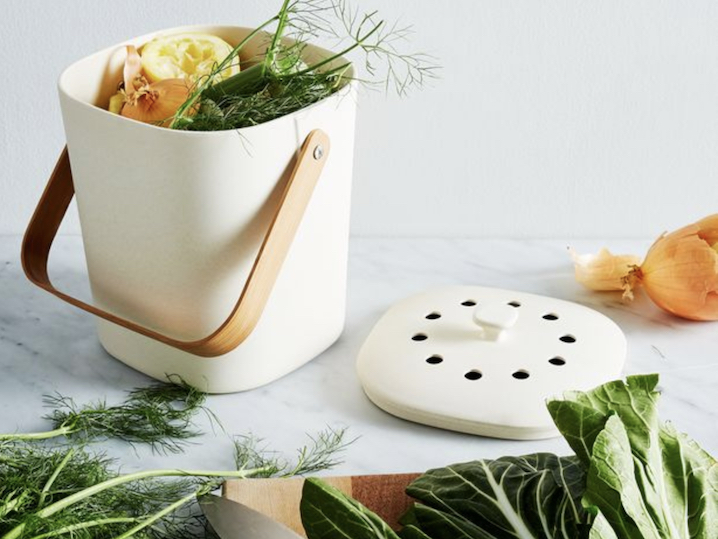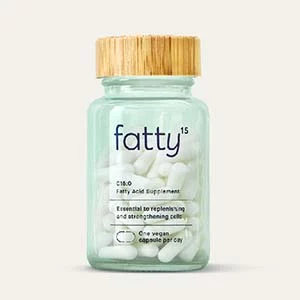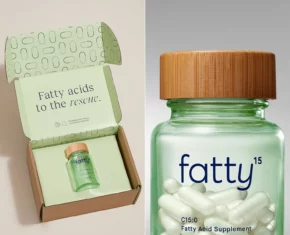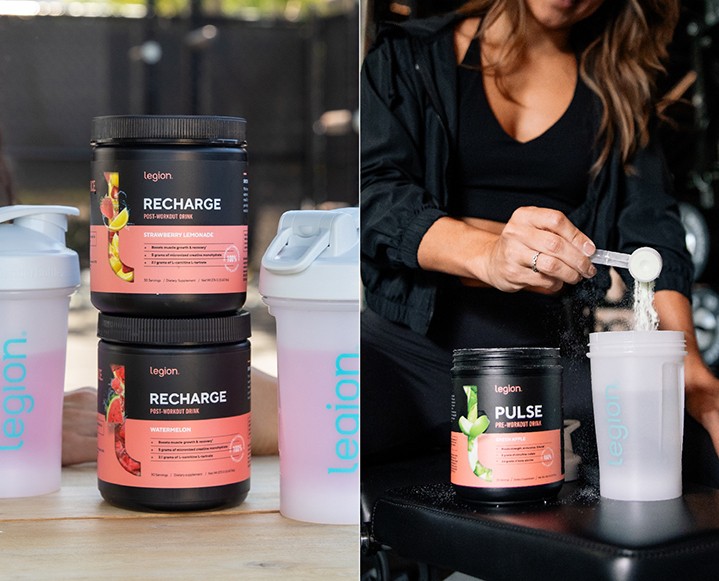Do you compost? What was once a routine part of life at home — back before fast food and other conveniences took the lead in our lives — composting can now seem like an extreme eco-effort. The truth is that composting is pretty easy and doesn’t have to be a big ordeal.
If you’ve got your own garden, this guide to composting for beginners is a must. If you aspire to have an edible garden one day in the future, learn about composting now as part of your journey. And if you live in the city and have little use for compost at all, consider finding a community garden near you that does (in California; elsewhere).
Start with a simple kitchen composter like this one and read our straightforward story with sustainability expert,
Lauren Olson, the Zero Waste Manager for leading compostable tableware provider, World Centric…
A Guide to Composting For Beginners
Learning how to compost is a great way to get outside, connect with nature and introduce environmental practices into daily life.
There are many misconceptions about at-home composting – things like cost, time commitment, smell — the list goes on. The truth is that, when done correctly, composting is a simple, cost-effective way to reduce waste and keep your yard and garden healthy. Here are all the simple steps you need to understand the basics of composting for beginners…
What the Heck Is Compost?
Compost is organic material that has decomposed. It is made by combining “green” items like food scraps and grass cuttings with “brown” items like leaves and wood chips, which then break down over time. The resulting material is nutrient-rich and can be used in gardens as a soil conditioner and natural pesticide.
Organic matter like food, food-soiled paper, and yard waste serves for more than a third of what gets thrown into the garbage. When sent to the landfill, these items creates methane, a greenhouse gas that is 25 times more powerful than carbon dioxide.
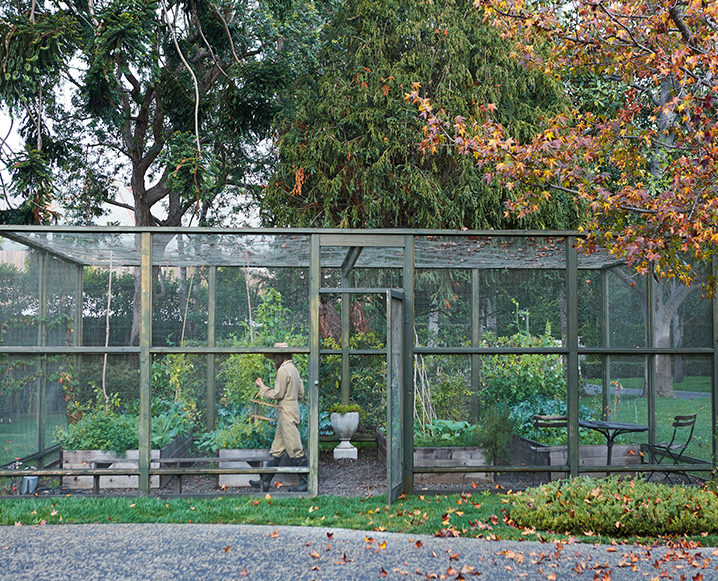
Gardening at home with the Edible Gardener
By composting, whether in your own backyard or with a local program you can save all those items and put them to good use, protecting our environment, savings landfill space, enriching soil — even creating jobs. And it’s easier than you might think.
Types of Home Composters
With a pretty small investment, you can turn your compostable scraps into nutrient-rich soil at home. There are several different kinds of home composters:
+ Manufactured compost bins, typically made out of plastic
+ Compost tumblers that can be easily turned by a handle for easy stirring
+ Wooden and pallet bins with compartments
+ Worm composting (vermi-composting) that use nature to help break down composted materials more quickly
Beginning to Compost:
Here’s What You Need to Know
To get started, follow these steps:
Step 1: Collect your “brown” and “green” compostable materials.
Browns – dry materials like wood chips, dried leaves, grass, and plants. It works even better when you rip or cut items into smaller pieces.
Greens – fresh, moist materials like grass cuttings and food scraps.
Step 2: Put an approximately equal amount of browns and greens into your composter. To ensure that your pile does not smell, add more browns (1 part green, 2 parts brown).
Step 3: Soak the compost pile with water — but don’t over soak; it should be about as damp as a wrung-out sponge.
Step 4: Wait a week, then add water, turn, and stir the pile.
Step 5: Keep adding, soaking, and stirring! Your compost should be ready to use in gardening in 3-6 months.
Be aware that many home composting systems are not well-suited for dairy, fish, meats, fats, or oil/grease, as these products take longer to break down and can attract pests.
Collecting Compostables in Your Kitchen
Collecting food and food-soiled paper in your kitchen doesn’t have to be a big hassle. There are many types of countertop containers, which you can line with a certified compostable bag, or simply rinse to keep clean.
As you clean up, you can scrape leftovers directly into the bin. Once the container is full, dump it into your outdoor collection bin or composting system. During the warmer months, you can keep your food scraps in the fridge or freezer, where they won’t smell or attract fruit flies. Editor’s Pick: Bamboozle Terracotta Composter
How To Fix Common Compost Issues
Home composting is easy, but there a few common issues that first-time composters run into…
Funny smells? Turn the pile and add some browns
Compost pile too dry? Spray some water, add in greens, and mix thoroughly
Fruit flies? Stir and add leaves or grass
Insects, raccoons, rats? There might be some meat or fatty food scraps in your bin. First, remove the meat or fats. You can also cover the pile with a heavy layer of soil, leaves or sawdust, or use an animal-proof composter.
What To Do With Takeout Containers + Compostable Products
If you eat out, you may bring home packaging labeled “compostable.” Containers, cups, and utensils like those made by World Centric are certified compostable in commercial composting systems by BPI, a third-party certification. This certification ensures that a product has been tested to revert to carbon dioxide, water, inorganic compounds, and biomass at a rate similar to paper.
Compostable products can be made from renewable plant fibers, wood paper, or compostable plastics. Products made from plant fibers or paper are not certified to break down at home, but you can experiment to see how they perform in your system.
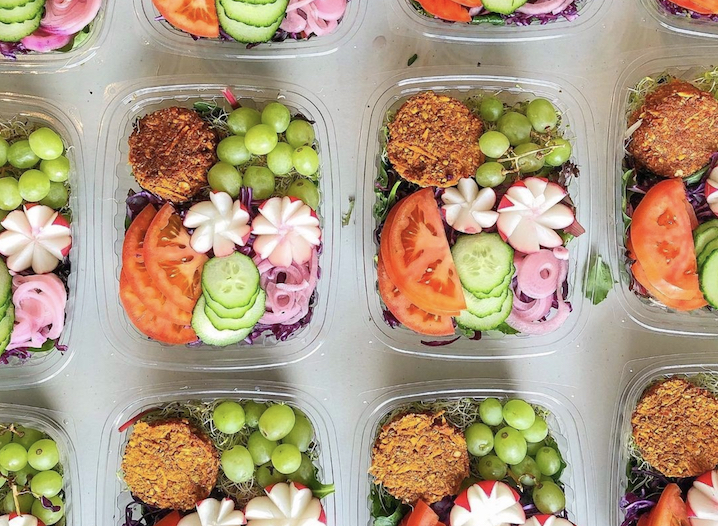
Photo credit: Jessica Valiant of Naturally Valiant
PLA (or polylactic acid) is a compostable bio-plastic made from corn starch
It helps to cut or rip them into smaller pieces. Compostable plastics should not be put into your home composting system, since they require higher heat to break down. Once you have an outdoor composter and a kitchen container for collecting material, you’ll be well on your way to turning waste into black gold.
Composting For Restaurants + the Foodservice Industry
Composting isn’t just something you can do at home or for your own garden! Our society has an urgent need for more widespread commercial composting facilities to keep food waste out of landfills, where it does harm to the environment by releasing methane, one of the most potent greenhouse gases.
Across North America, many restaurants are discovering small-scale community composters that are stepping up to help local residents and foodservice operators reduce their waste.
Compostable products are designed to be part of a circular economy. This is a system in which plant-based products biodegrade to become compost, and we use that compost to grow plants and subsequently create the products again.
The Circular Economy
An example of composting for beginners on the commercial side of things is Snowy Owl Coffee, a local Massachusetts coffee shop that uses and diverts all their compostable World Centric cups, napkins, lids, and straws to Black Earth Compost — instead of the landfill. Black Earth Compost collects all organic waste and compostable packaging, composts it and sells the finished compost back to garden centers throughout the local area – creating a completely closed loop.
Another example is Las Olas, a seaside Mexican restaurant that’s been operating sustainably in San Diego, California for over 40 years. Las Olas partnered with The Compost Group and became the first full-service restaurant in North County San Diego to compost food waste. Each month, Las Olas diverts over 5,000 lbs of food waste and compostables from the landfill. “We do everything we can to be an environmentally conscious operation in an effort to protect ‘la tierra’ (the land), and ‘las olas’ (the waves).”
Las Olas uses only compostable foodservice ware for takeout operations, recycles all cooking oil to help fuel local school buses, and hosts yearly community beach cleanups. A strong advocate for environmental and city developmental issues, Las Olas had been leading the way in sustainability and setting an example for the local community on how to run a business and respect the environment since the early 80’s.
Naomi Wentworth is the founder of The Compost Group in San Diego. Frustrated by the lack of composting options for food waste in San Diego County, and with a background in climate policy, Naomi saw an opportunity to start a business picking up food scraps from local restaurants and residential communities and composting them.
“Moving into an apartment in Encinitas where I could not compost in my backyard, I would just feel my heart sink every time I put those beautiful coffee grounds, egg shells, and vegetable trimmings into the garbage to go to landfill,” explains Naomi. “I started The Compost Group because I was frustrated by the amount of food waste being sent to landfills in my community.”
The Compost Group is helping divert food scraps and compostable packaging from landfills. In 2020 alone, they turned 59,187 pounds of organic waste into soil.
“Of all the difficult solutions to complex problems we are facing as a society,”says Naomi, “returning our nutrients to the soil is a really simple and easy solution.”
Author Bio: Lauren K. Olson is the Zero Waste Manager at World Centric. Lauren holds a Master’s degree in Community Sustainability specializing in decision-making about waste, and a Bachelor of Science’s degree in Environmental Economics– both degrees from Michigan State University.




